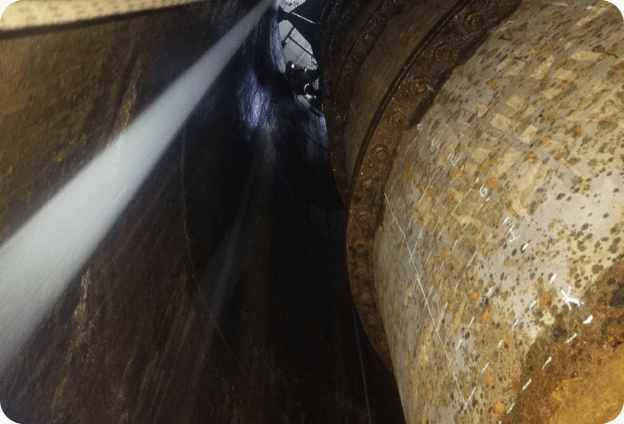Hanging in There: Rope Access Inspections Deliver Safety, Speed & Results

When it comes to difficult inspections, Industrial Inspection & Analysis (IIA) never leaves our clients hanging. In cases involving confined spaces or elevations, we call upon a unique breed of inspector: the rope access inspector.
What is a Rope Access Inspector?
Seemingly fearless, rope access certified inspectors skillfully navigate tricky inspection scenarios using a system of ropes to climb, descend or move laterally across the structure or site.
Using techniques that originated in the climbing and caving sectors, the Industrial Rope Access Trade Association (IRATA) certifies personnel to safely use rope access techniques in a wide range of repair, maintenance and inspection work.
Technicians who earn the Level 1 IRATA rope access certification are trained to safely lift and lower themselves on a set of ropes, as well as different techniques to maneuver around structures and obstacles. This eliminates the need for a second person to maneuver the ropes from above.
Rope Access Applications
From amusement parks to wells, rope access inspections are used in an array of industries and situations. Rope access is an efficient and affordable method of accessing challenging inspection environments, such as:
- Industrial Equipment & Structures
- Process Piping
- Tanks & Pressure Vessels
- Bridges & Towers
- Penstocks
- Wind Turbines
- Other Complex Steel & Concrete Structures
IIA’s Rope Access Testing Capabilities
IIA is equipped to perform the following rope access non-destructive testing (NDT) and other testing services:
- Visual Inspection
- Magnetic Particle
- Dye Penetrant
- Ultrasonics
- Positive Material Identification
- Hardness Testing
Our rope access jobs typically involve visual, ultrasound or magnetic particle testing of steel components. Rest assured, our inspectors are experienced and fully certified to perform the testing required for your job — whether their feet are firmly planted on the ground or they are performing rope access inspections beneath a bridge or deep inside a well.
Safety First
Clearly, rope access jobs are not for the faint of heart. (Claustrophobes and acrophobes need not apply.)
In light of the inherent dangers of working at heights and in confined spaces, Level 1 rope access technicians never work solo. They always work alongside at least two other certified personnel for the purpose of rigging (Level 2) and rescue (Level 3). Detailed planning for potential rescues is part of every job.
Benefits of Rope Access Inspections
In spite of the risks, rope access inspections are extremely safe compared to other alternatives. In fact, safety and speed are the main advantages of rope access techniques.
Because they can be installed and dismantled quickly — and often require fewer personnel — rope access inspections can be 30 to 80% more cost-effective (and less disruptive) than alternative methods, such as scaffolding, cranes or manlifts.
According to IRATA, “Rope access methodology boasts an unrivalled safety record, short set-up and dismantling time, positive environmental benefits and removes the need for invasive access equipment or disruption to a worksite.”
If you’re at the end of your rope with a difficult inspection situation, rope access by qualified personnel may deliver the answers you need.
Does your inspection challenge call for rope access expertise?
CONTACT US for a quote.




